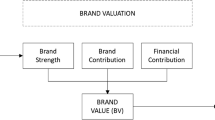Abstract
Brand value has become an important corporate performance metric, as can be observed from the close following of the annual Top 100 Brand Values ranked by brand consultancy firm Interbrand and reported in Business Week. In this study, we employ a simultaneous equations model to examine the non-linear influence of lagged advertising, marketing promotions and R&D expenses on brand value after controlling for net income and lagged brand valuation. We infer that these lagged expenses yield diminishing returns to brand value. The effect of R&D expense is the weakest, possibly because it is confounded with the advertising and promotional effects. Differences across industry segments or country base are not statistically significant.
Similar content being viewed by others
References
Aaker, D.A., & Carman, J.M. (1982). Are you Overadvertising? Journal of Advertising Research, 22 (August-September), 57–70.
Aykac, A., Corstjens, M., Gautschi, D., & Horowitz, I. (1989). Estimation Uncertainty And Optimal Advertising Decisions. Management Science, 35(1), 42–50.
Belch, G.E., & Belch, M.A. (2004). Advertising and promotion: an integrated marketing communications perspective, 6th(ed.), New York: NY: McGraw-Hill.
Berkowitz, D., Allaway, A., & D’Souza, G. (2001). Estimating Differential Lag Effects for Multiple Media Across Multiple Stores. Journal of Advertising, 30(Winter), 59–65.
Berner, R., & Kiley, D. (2005). Global Brands: Business Week/Interbrand Rank the Companies that Best Built Their Images and Made Them Stick. Business Week (issue 3945), August 1. [Available at http://www.businessweek.com/magazine/content/05_31/b3945098.htm]
Blattberg, R.C., & Levin, A. (1987). Modeling the Effectiveness and Profitability of Trade Promotions. Marketing Science, 6(2), 124–146.
Chan, K.C., Lakonishok, J., & Sougiannis, T. (2001). The Stock Market Valuation of Research and Development Expenditure. Journal of Finance, 56(6), 2431–2456.
Chaudhuri, A. (2002). How Brand Reputation Affects the Advertising-Brand Equity Link. Journal of Advertising Research, 42(May/June), 33–43.
Clarke, D.G. (1976). Econometric Measurement of the Duration of Advertising Effect on Sales. Journal of Marketing Research, 13(November), 345–357.
Cobb-Walgren, C.J., Ruble, C. A., & Donthu, N. (1995). Brand equity, brand preference, and purchase intent.Journal of Advertising, 24(Fall), 25–40.
Corstjens, M., & Merrihue, J. (2003). Optimal marketing. Harvard Business Review, 81 (October), 114–121.
Erickson, G., & Jacobson, R. (1992). Gaining Comparative Advantage through Discretionary Expenditures: The returns to R&D and advertising. Management Science, 38(September), 1264–1279.
Ho, Y.K., Keh, H.T., & Ong, J. (2005). The effects of /rm R&D and advertising on firm value: An Examination of Manufacturing and Non-Manufacturing Firms. IEEE Transactions on Engineering Management, 52(1), 3–14.
Kallapur, S., & Kwan, S.Y.S. (2004). The Value Relevance and Reliability of Brand Assets Recognized by UK firms. Accounting Review, 79(January), 151–172.
Keller, K.L. (2003). Strategic brand management: building, Measuring, and Managing Brand Equity, 2nd ed., Upper Saddle River, NJ: Prentice-Hall.
Keller, K.L., & Lehmann, D. R. (2003). How do Brands Create Value? Marketing Management, 12(3), 26–31.
Kerin, R.A., & Sethuraman, R. (1998). Exploring the Brand Value-Shareholder Value Nexus for Consumer Goods Companies. Journal of the Academy of Marketing Science, 26(4), 260–273.
Mela, C.F., Gupta, S., & Lehmann, D.R. (1997). The Long-Term Impact of Promotion and Advertising on Consumer Brand Choice.Journal of Marketing Research, 34(May), 248–261.
Mizik, N., & Jacobson, R. (2003). Trading Off Between Value Creation and Value Appropriation: The Financial Implications of Shifts in Strategic Emphasis. Journal of Marketing, 67(January), 63–76.
Naik, P.A., Raman, K., & Winer, R.S. (2005). Planning Marketing-Mix Strategies in the Presence of Interaction Effects. Marketing Science, 24(1), 25–34.
Pedhazur, E.J. (1997), Multiple Regression in Behavioral Research. Orlando, FL: Harcourt Brace.
Simon, C.J., & Sullivan, M.W. (1993). The Measurement and Determinants of Brand Equity: A financial approach. Marketing Science, 12(Winter), 28–52.
Tull, D.S., Wood, V.R., Duhan, D., Gillpatrick, T., Robertson, K.R., & Helgeson, J.G. (1986). Leveraged Decision Making in Advertising: The Flat Maximum Principle and its Implications. Journal of Marketing Research, 23(February), 25–32.
Author information
Authors and Affiliations
Corresponding author
Rights and permissions
About this article
Cite this article
Chu, S., Keh, H.T. Brand value creation: Analysis of the Interbrand-Business Week brand value rankings. Market Lett 17, 323–331 (2006). https://doi.org/10.1007/s11002-006-9407-6
Issue Date:
DOI: https://doi.org/10.1007/s11002-006-9407-6




